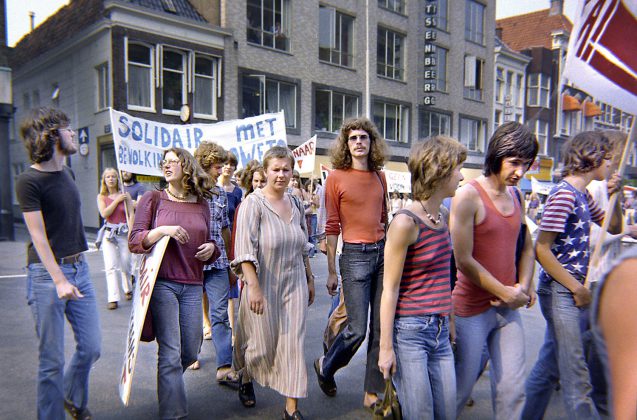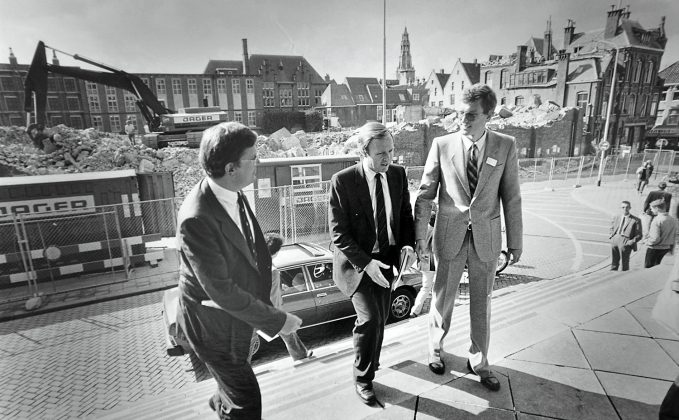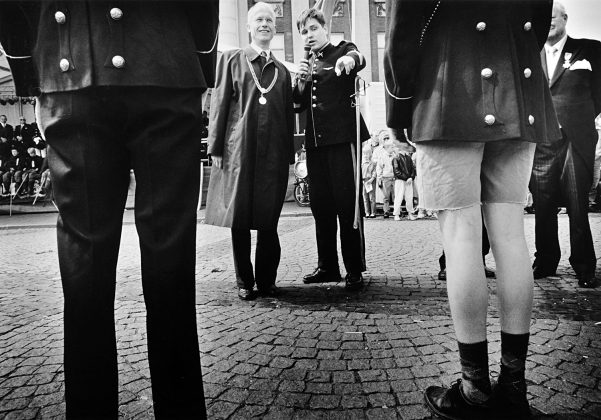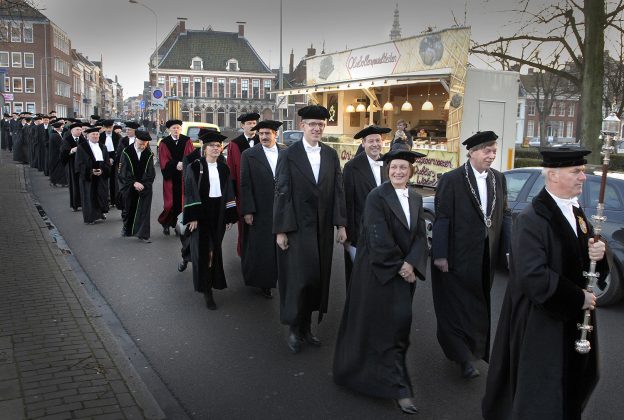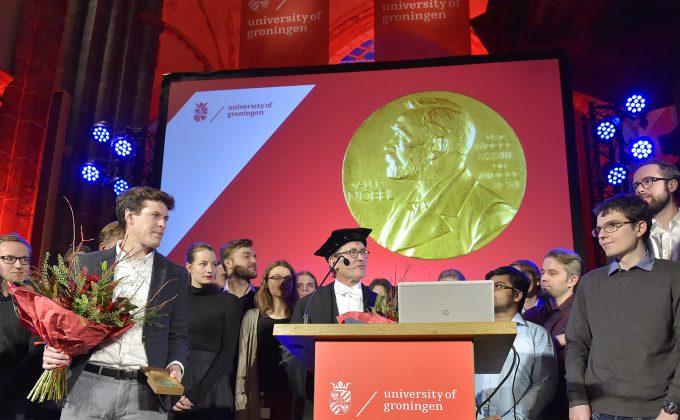Photographer Elmer Spaargaren
Time travel through photography
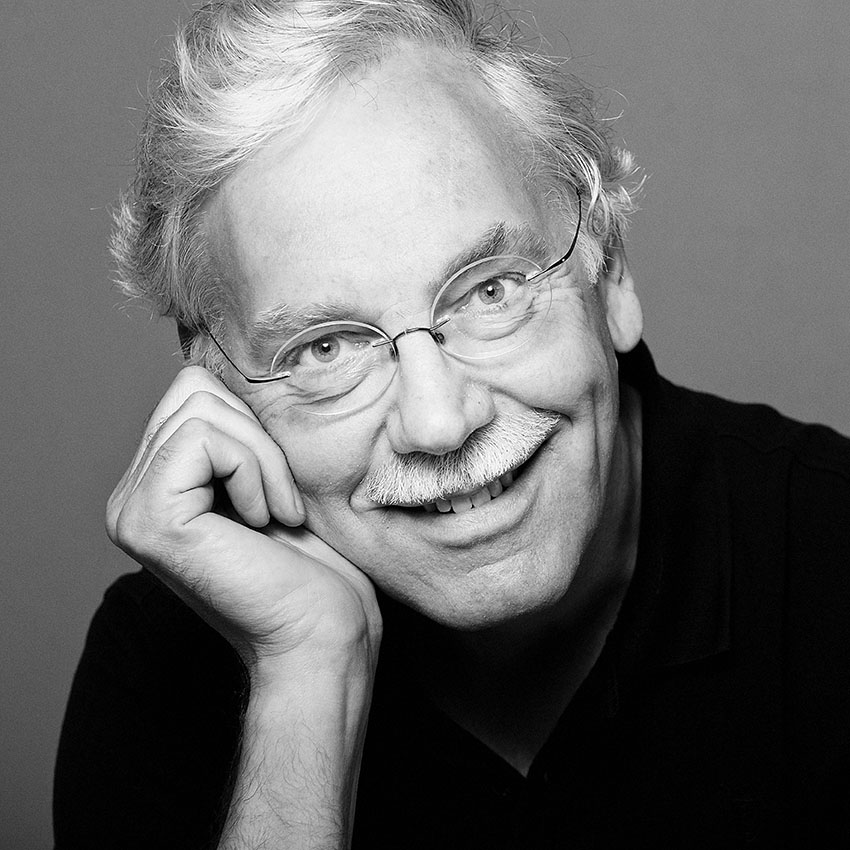
Lead photo: In 1989, Russian physicist Andrej Dmitrievitsj Sacharov was awarded an honorary doctorate at the RUG. Sacharov, considered to be the spiritual father of the Russian hydrogen bomb, argued for stopping any further development of nuclear weapons. This made him a well-known dissident in Russia in the eighties and nineties, but it also won him a Nobel Peace Prize.
‘This photo was taken during a press conference in the Familiehotel in Paterswolde’, Spaargaren recalls. ‘This was the morning he received his honorary doctorate. He doesn’t look very happy because he was exhausted. Sacharov would die later that year.’
The perfect time and the perfect place coming together to lead to the perfect photo: it is every photographer’s dream. For 40 years, Elmer Spaargaren served as the RUG’s unofficial resident photographer. And for part of those four decades, he was the Universiteitskrant’s official photo source as well.
The thousands of photos that Spaargaren took during that time reveal a surprising picture of the development of Groningen as a city of students. The black-and-white images show buildings that did not survive to the 21st century. A frame from the seventies shows protesting students sporting hairdos that did not stand the test of time. And then there is the picture of a beaming Ben Feringa during his Nobel Prize lecture at the Martini church last year.
Spaargaren collected his best work in a book of photos, City & University / Academic city Groningen in pictures. That book in turn forms the basis for an exhibition in the GRID Graphic Museum. Just for the UK, Spaargaren selected several of his photographs and added his own personal commentary.
The year is 1978, and it is the height of summer. A long procession of students and members from political youth organisations is making its way from the Akerkhof to the Munnekeholm, protesting Apartheid in South Africa. One of the banners says ‘Solidarity to the people of Soweto’, referring to the townships south-west of Johannesburg, where bloody revolts have been taking place since 1976.
‘The strength of this picture lies in how it portrays the spirit of the era’, Spaargaren says. ‘It really shows what was going on at that time. The anti-Apartheid movement was a global movement, and even in Groningen, there were large solidarity movements that protested the race segregation in South Africa and what is today Namibia.’
In 1982, then education minister Jan Terlouw (middle) climbed the steps of the Academy building. Behind his car is a completely different view than what we are accustomed to: instead of the current University Library (UB), this photo shows the ruins of the former Saint Martinus church. The church was built in 1895, but had to make way for the new library. The building on the right – which then housed a stamp store – was allowed to stay: the property on the corner of the Kijk in ‘t Jatstraat currently houses the University store.
The scene reminds Spaargaren of the discussion about the new UB that was taking place at the time – a discussion he actively participated in. ‘I was on the University Council from 1977 to 1978, in the Groningen Student Union faction’, says Spaargaren. ‘That year, we had to decide where the new UB would be located. It was an extraordinarily heated debate. When the contractors started their demolition work shortly thereafter, it was a bitter pill to swallow.’
The Siege of Groningen, Grote Markt, early nineties. Then Mayor Jos Staatsen inspects the members of Vindicat’s Student Resilience. This special combat unit of the army dates back to 1665. Back then, Groningen was under siege from the Münster bishop Bernhard von Galen, better known as Bommen Berend. Under the name Voluntary Flankers, students helped to protect the city from the German bishop who greatly harmed the city with his artillery.
Why the student on the right in the photo is wearing shorts, Spaargaren does not know. ‘The mayor seems a little critical because the men in the Student Resilience should really be dressed impeccably’, he explains. Staatsen also expressed his displeasure verbally, Spaargaren remembers: ‘He thought the formation of these men on 28 August was “a motley bunch”.’
In 2008, a procession of approximately 50 professors marches from the Nieuwe Boteringestraat to the Nieuwe Kerk. Behind the beadle, next to then rector magnificus Frans Zwarts, is Cisca Wijmenga, followed closely by her (since deceased) husband Marten Hofkar. The pair, both professors in genetics, will give a double lecture in the church about the value of our DNA.
‘This procession of professors, on the way to the church on a cold morning, is not something you see every day’, Spaargaren explains. ‘I sometimes think they might be feeling a little embarrassed. I think the food stand in the back serves as a nice counterpoint.’
It is late November 2016 as Ben Feringa gets up on stage in the Martini church to give his Nobel Prize Lecture. The RUG professor in organic chemistry was informed on 5 October that he – together with a Frenchman and a Briton – had won the Nobel Prize for Chemistry. After the lecture in the church, the professor calls his research group onto the stage to emphasise that he did not do this on his own: ‘It was a team effort’, says Feringa. That same afternoon he – as citizen of the Tynaarlo municipality – is awarded the honorary medal of the city of Groningen.
‘This photo marks an important moment in the history of the RUG’, says Spaargaren. ‘What I noticed in Feringa’s lecture were the photos of his parents and their farm. Once again, Feringa showed that he didn’t do it on his own, but that he owes a lot to his family, the teacher at his school who made his students enthusiastic, as well as his colleagues and his team.’
Elmer Spaargaren / Photo by Reyer Boxem
The perfect time and the perfect place coming together to lead to the perfect photo: it is every photographer’s dream. For 40 years, Elmer Spaargaren served as the RUG’s unofficial resident photographer. And for part of those four decades, he was the Universiteitskrant’s official photo source as well.
The thousands of photos that Spaargaren took during that time reveal a surprising picture of the development of Groningen as a city of students. The black-and-white images show buildings that did not survive to the 21st century. A frame from the seventies shows protesting students sporting hairdos that did not stand the test of time. And then there is the picture of a beaming Ben Feringa during his Nobel Prize lecture at the Martini church last year.
Spaargaren collected his best work in a book of photos, City & University / Academic city Groningen in pictures. That book in turn forms the basis for an exhibition in the GRID Graphic Museum. Just for the UK, Spaargaren selected several of his photographs and added his own personal commentary.
The year is 1978, and it is the height of summer. A long procession of students and members from political youth organisations is making its way from the Akerkhof to the Munnekeholm, protesting Apartheid in South Africa. One of the banners says ‘Solidarity to the people of Soweto’, referring to the townships south-west of Johannesburg, where bloody revolts have been taking place since 1976.
‘The strength of this picture lies in how it portrays the spirit of the era’, Spaargaren says. ‘It really shows what was going on at that time. The anti-Apartheid movement was a global movement, and even in Groningen, there were large solidarity movements that protested the race segregation in South Africa and what is today Namibia.’
In 1982, then education minister Jan Terlouw (middle) climbed the steps of the Academy building. Behind his car is a completely different view than what we are accustomed to: instead of the current University Library (UB), this photo shows the ruins of the former Saint Martinus church. The church was built in 1895, but had to make way for the new library. The building on the right – which then housed a stamp store – was allowed to stay: the property on the corner of the Kijk in ‘t Jatstraat currently houses the University store.
The scene reminds Spaargaren of the discussion about the new UB that was taking place at the time – a discussion he actively participated in. ‘I was on the University Council from 1977 to 1978, in the Groningen Student Union faction’, says Spaargaren. ‘That year, we had to decide where the new UB would be located. It was an extraordinarily heated debate. When the contractors started their demolition work shortly thereafter, it was a bitter pill to swallow.’
The Siege of Groningen, Grote Markt, early nineties. Then Mayor Jos Staatsen inspects the members of Vindicat’s Student Resilience. This special combat unit of the army dates back to 1665. Back then, Groningen was under siege from the Münster bishop Bernhard von Galen, better known as Bommen Berend. Under the name Voluntary Flankers, students helped to protect the city from the German bishop who greatly harmed the city with his artillery.
Why the student on the right in the photo is wearing shorts, Spaargaren does not know. ‘The mayor seems a little critical because the men in the Student Resilience should really be dressed impeccably’, he explains. Staatsen also expressed his displeasure verbally, Spaargaren remembers: ‘He thought the formation of these men on 28 August was “a motley bunch”.’
In 2008, a procession of approximately 50 professors marches from the Nieuwe Boteringestraat to the Nieuwe Kerk. Behind the beadle, next to then rector magnificus Frans Zwarts, is Cisca Wijmenga, followed closely by her (since deceased) husband Marten Hofkar. The pair, both professors in genetics, will give a double lecture in the church about the value of our DNA.
‘This procession of professors, on the way to the church on a cold morning, is not something you see every day’, Spaargaren explains. ‘I sometimes think they might be feeling a little embarrassed. I think the food stand in the back serves as a nice counterpoint.’
It is late November 2016 as Ben Feringa gets up on stage in the Martini church to give his Nobel Prize Lecture. The RUG professor in organic chemistry was informed on 5 October that he – together with a Frenchman and a Briton – had won the Nobel Prize for Chemistry. After the lecture in the church, the professor calls his research group onto the stage to emphasise that he did not do this on his own: ‘It was a team effort’, says Feringa. That same afternoon he – as citizen of the Tynaarlo municipality – is awarded the honorary medal of the city of Groningen.
‘This photo marks an important moment in the history of the RUG’, says Spaargaren. ‘What I noticed in Feringa’s lecture were the photos of his parents and their farm. Once again, Feringa showed that he didn’t do it on his own, but that he owes a lot to his family, the teacher at his school who made his students enthusiastic, as well as his colleagues and his team.’


